Variations in Winter Ocean Wave Climate in the Japan Sea under the Global Warming Condition
Abstract
:1. Introduction
2. Methods
2.1. Forcing Data forWave Simulations
2.2. Wave Simulation (WaveWatch III)
3. Results
3.1. Validation of Present Wave Climate Simulated by WW3
3.2. Future Variations of Wave Characteristics around Japan
3.3. Details of Future Variations of Wave Characteristics at Kanazawa and Akita
4. Conclusions
Author Contributions
Funding
Acknowledgments
Conflicts of Interest
References
- Wang, X.L.; Swail, V.R. Climate change signal and uncertainty in projections of ocean wave height. Clim. Dyn. 2006, 26, 109–126. [Google Scholar] [CrossRef]
- Wang, X.L.; Feng, Y.; Swail, V.R. Changes in global ocean wave heights as projected using multi-model CMIP5 simulations. Geophys. Res. Lett. 2014, 41, 1026–1034. [Google Scholar] [CrossRef]
- Taylor, K.E.; Stouffer, R.K.; Meehl, G.A. An overview of CMIP5 and the experiment design. Bull. Am. Meteorol. Soc. 2012, 93, 485–498. [Google Scholar] [CrossRef]
- Perez, J.; Menendez, M.; Camus, P.; Mendez, F.J.; Losada, I.J. Statistical multi-model climate projections of surface ocean waves in Europe. Ocean Model. 2015, 96, 161–170. [Google Scholar] [CrossRef]
- Mori, N.; Yasuda, T.; Mase, H.; Tom, T.; Oku, Y. Projection of extreme wave climate change under global warming. Hydrol. Res. Lett. 2010, 4, 15–19. [Google Scholar] [CrossRef]
- Charles, E.; Idier, D.; Delecluse, P.; Déqué, M.; Le Cozannet, G. Climate change impact on waves in the Bay of Biscay, France. Ocean Dyn. 2012, 62, 831–848. [Google Scholar] [CrossRef]
- Groll, N.; Grabemann, I.; Gaslikova, L. North Sea wave conditions: An analysis of four transient future realizations. Ocean Dyn. 2014, 64, 1–12. [Google Scholar] [CrossRef]
- Grabemann, I.; Groll, N.; Möller, J.; Weisse, R. Climate change impact on North Sea wave conditions: A consistent analysis of ten projections. Ocean Dyn. 2015, 65, 255–267. [Google Scholar] [CrossRef]
- Hemer, M.A.; Katzfey, J.; Trenham, C.E. Global dynamical projections of surface ocean wave climate for a future high green gas emission scenario. Ocean Model. 2013, 70, 221–245. [Google Scholar] [CrossRef]
- Semedo, A.; Weisse, R.; Behrens, A.; Sterl, A.; Bengtsson, L.; Günter, H. Projection of global wave climate change toward the end of the twenty-first century. J. Clim. 2013, 26, 8269–8288. [Google Scholar] [CrossRef]
- Fan, Y.; Lin, S.-J.; Griffies, S.M.; Hemer, M.A. Simulated global swell and wind-sea climate and their response to anthropogenic climate change at the end of the twenty-first century. J. Clim. 2014, 27, 3516–3536. [Google Scholar] [CrossRef]
- Erikson, L.H.; Hegermiller, C.A.; Barnard, P.L.; Ruggiero, P.; van Ormondt, M. Projected wave conditions in the Eastern North Pacific under the influence of two CMIP5 climate scenarios. Ocean Model. 2015, 96, 171–185. [Google Scholar] [CrossRef]
- Shimura, T.; Mori, N.; Mase, H. Future projection of ocean wave climate: Analysis of SST impacts on wave climate change in the western North Pacific. J. Clim. 2015, 28, 3171–3190. [Google Scholar] [CrossRef]
- Laugel, A.; Menendez, M.; Benoit, M.; Mattarolo, G.; Méndez, F. Wave climate projections along the French coastline: Dynamical versus statistical downscaling. Ocean Model. 2014, 84, 35–50. [Google Scholar] [CrossRef]
- Martínez-Asensio, A.; Marcos, M.; Tsimplis, M.N.; Jordà, G.; Feng, X.; Gomis, D. On the ability of wind-wave models to capture the variability and long-term trends of the North Atlantic winter wave climate. Ocean Model. 2016, 103, 177–189. [Google Scholar] [CrossRef]
- Mori, N.; Shimura, T.; Yasuda, T.; Mase, H. Multi-model climate projections of ocean surface variables under different climate scenarios—Future change of waves, sea level and wind. Ocean Eng. 2013, 71, 122–129. [Google Scholar] [CrossRef]
- Hemer, M.A.; Trenham, C.E. Evaluation of a CMIP5 derived dynamical global wind wave climate model ensemble. Ocean Model. 2016, 103, 190–203. [Google Scholar] [CrossRef]
- Sato, T.; Kimura, F.; Kitoh, A. Projection of global warming onto regional precipitation over Mongolia using a regional climate model. J. Hydrol. 2007, 333, 144–154. [Google Scholar] [CrossRef]
- Taniguchi, K. Future changes in precipitation and water resources for Kanto Region in Japan after application of pseudo global warming method and dynamical downscaling. J. Hydrol. Reg. Stud. 2016, 8, 287–303. [Google Scholar] [CrossRef]
- Skamarock, W.C.; Klemp, J.B.; Dudhia, J.; Gill, D.O.; Barker, D.M.; Duda, M.G.; Huang, X.-Y.; Wang, W.; Powers, J.G. A description of the advancedresearch WRF version 3. NCAR. Tech. Note NCAR/TN-475 + STR 2008, 113. [Google Scholar] [CrossRef]
- Onogi, K.; Tsutsui, J.; Koide, H.; Sakamoto, M.; Kobayashi, S.; Hatsushika, H.; Matsumoto, T.; Yamazaki, N.; Kamahori, H.; Takahashi, K.; et al. The JRA-25 Reanalysis. J. Meteorol. Soc. Jpn. 2007, 85, 369–432. [Google Scholar] [CrossRef]
- Tolman, H.L. User manual and system documentation of WaveWatch III version 3.14. Tech. Note MMAB Contrib. 2009, 276, 220. [Google Scholar]
- Tolman, H.L.; Chalikov, D.V. Source term in a third-generation wind-wave model. J. Phys. Oceanogr. 1996, 26, 2497–2518. [Google Scholar] [CrossRef]
- Welch, B.L. The significance of the difference between two means when the population variances are unequal. Biometrika 1938, 29, 350–362. [Google Scholar] [CrossRef]
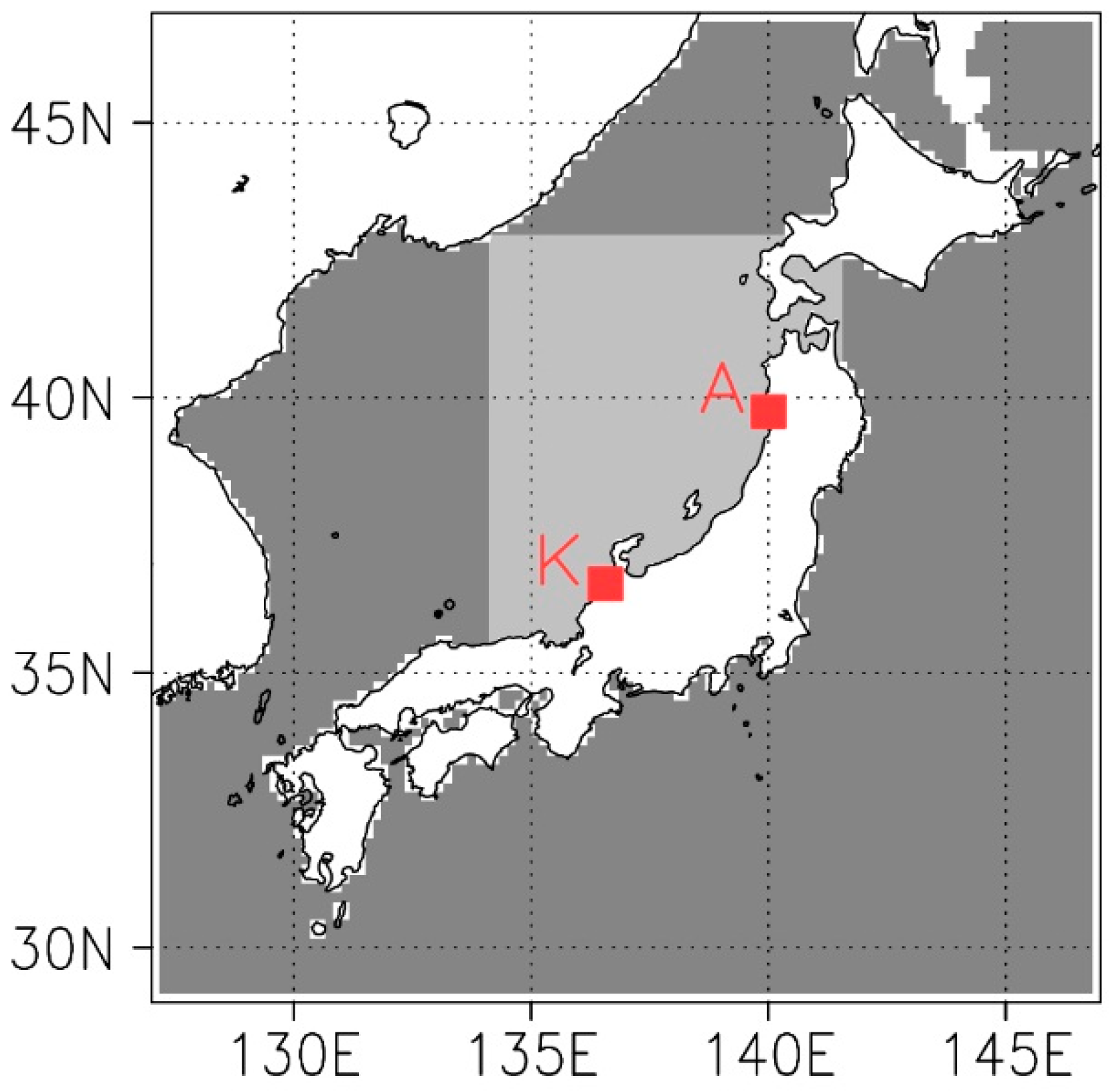
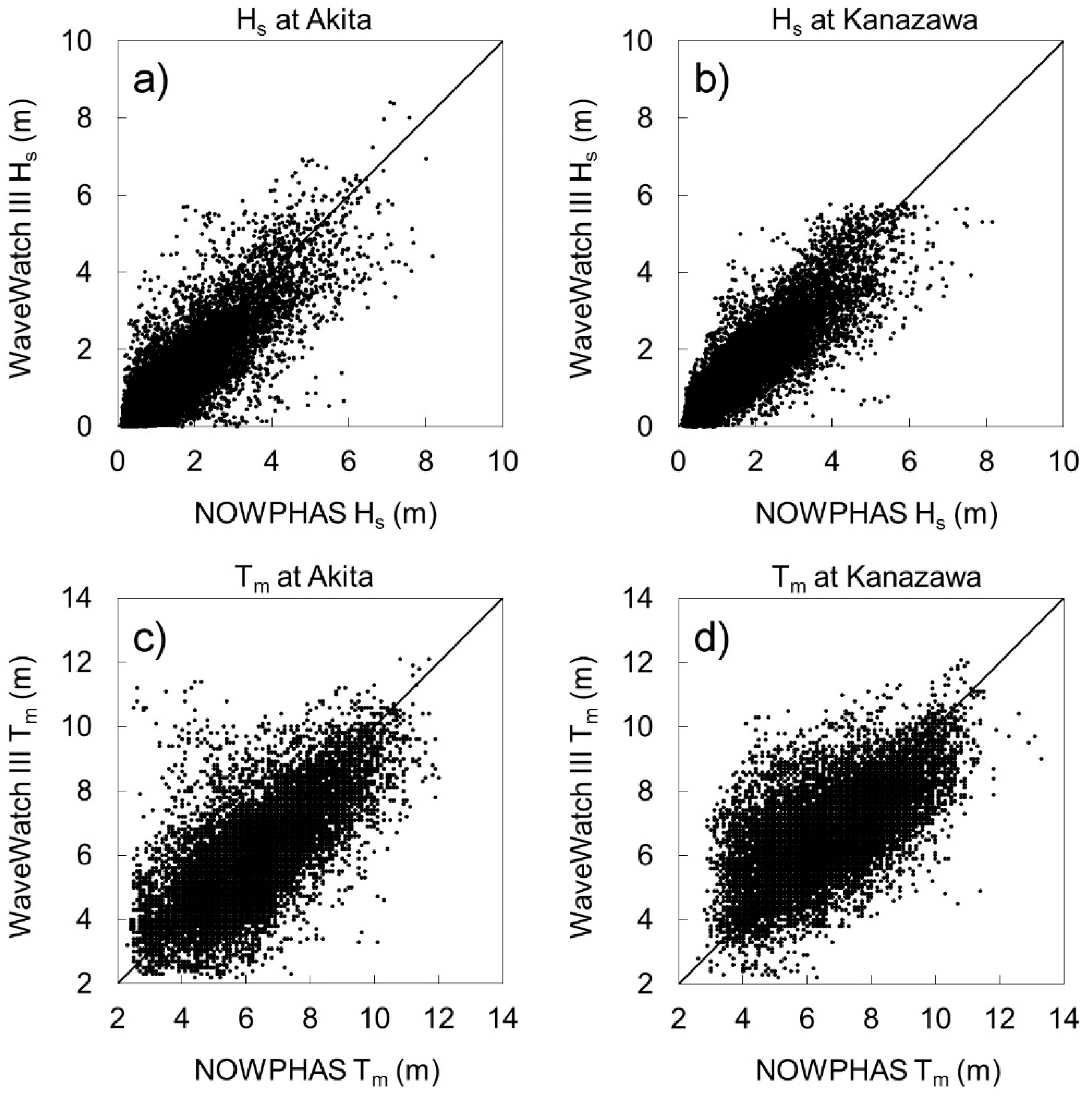

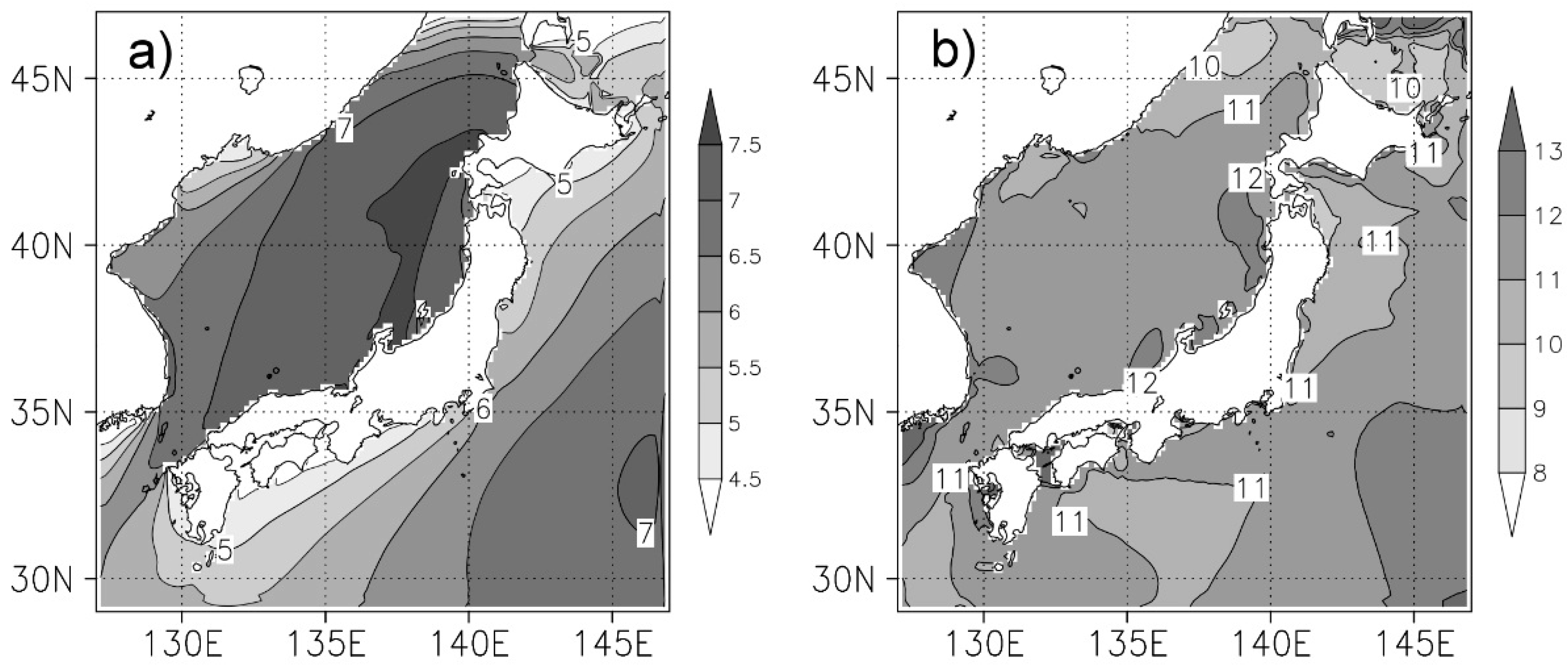
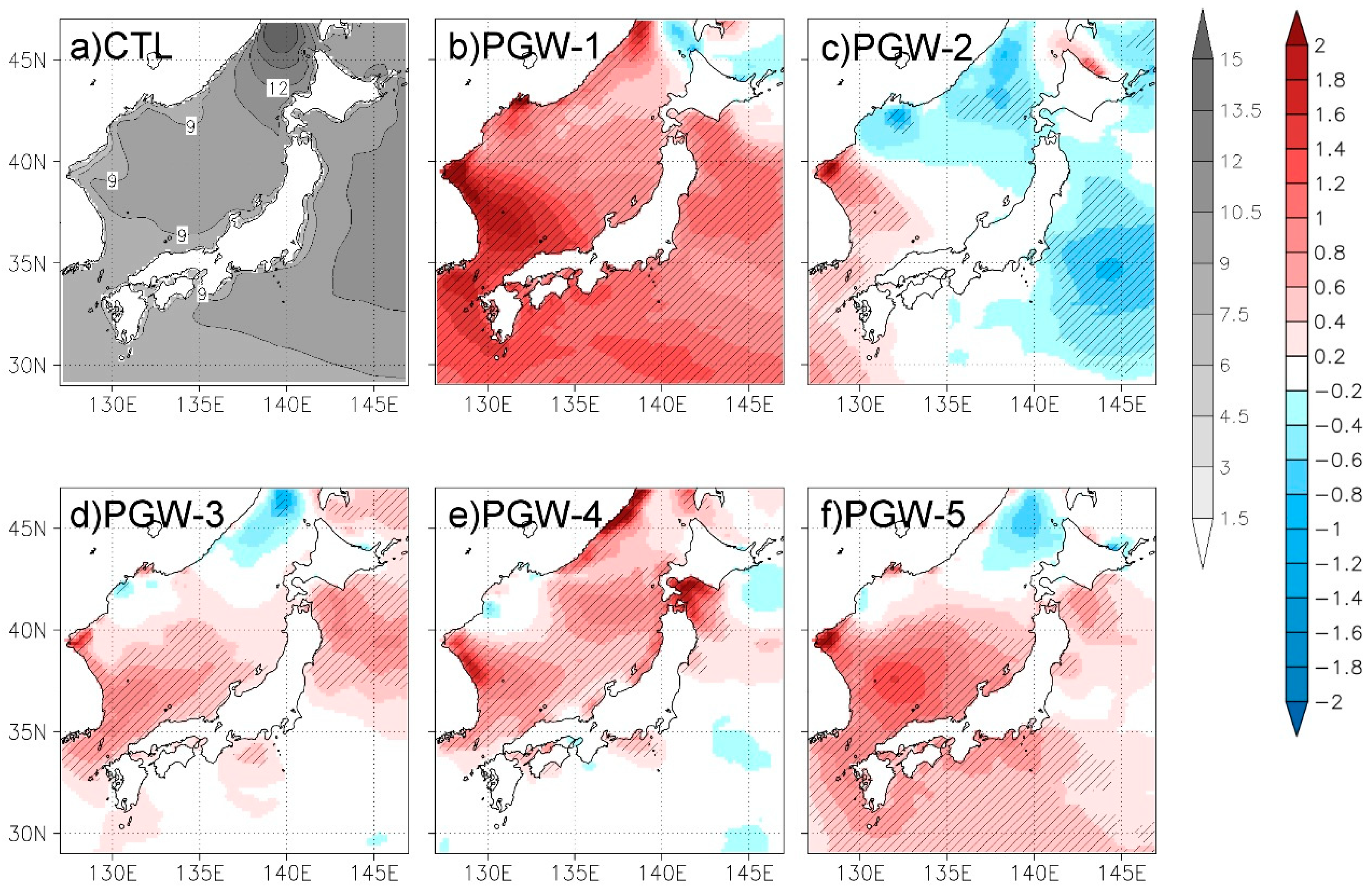
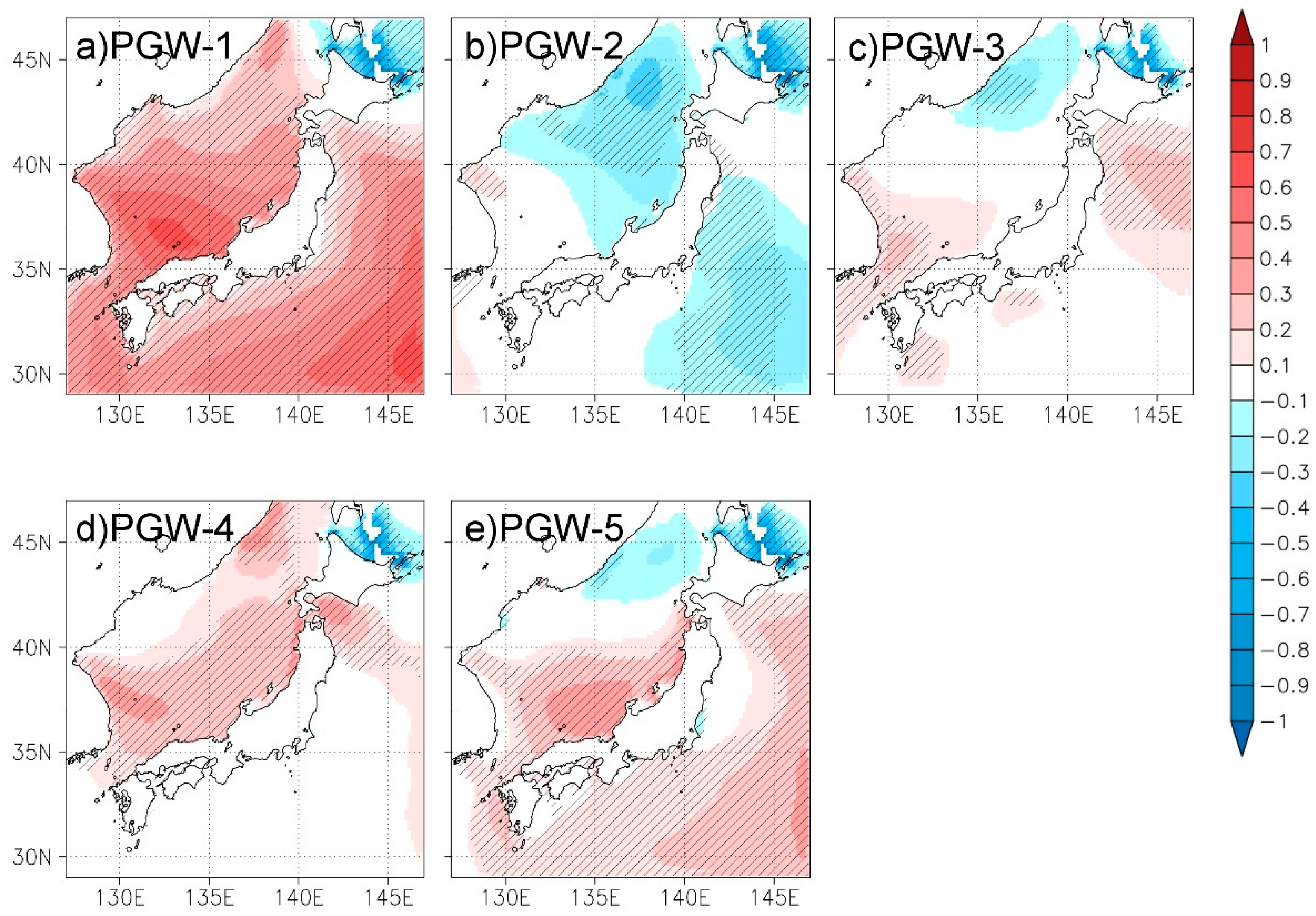
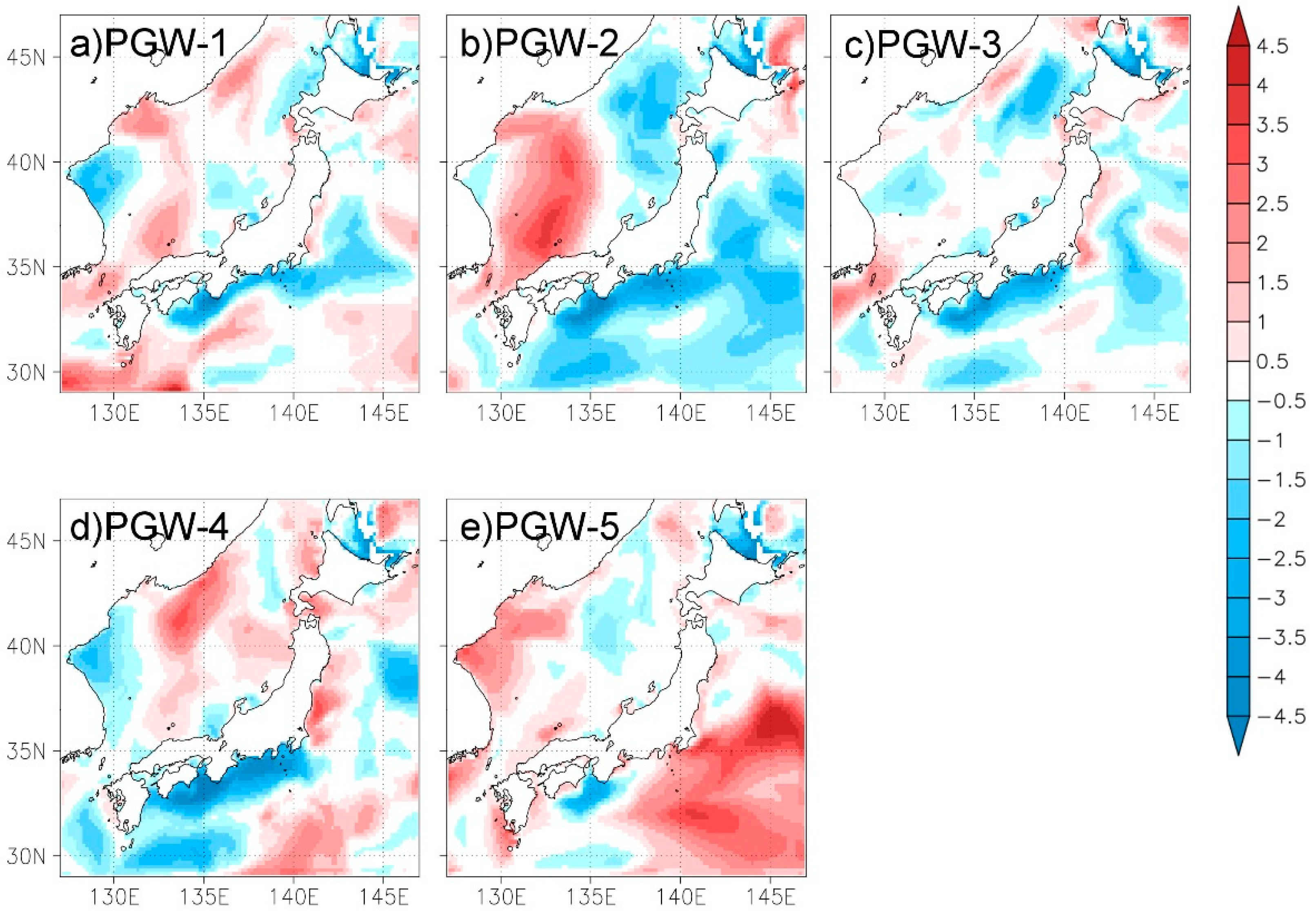
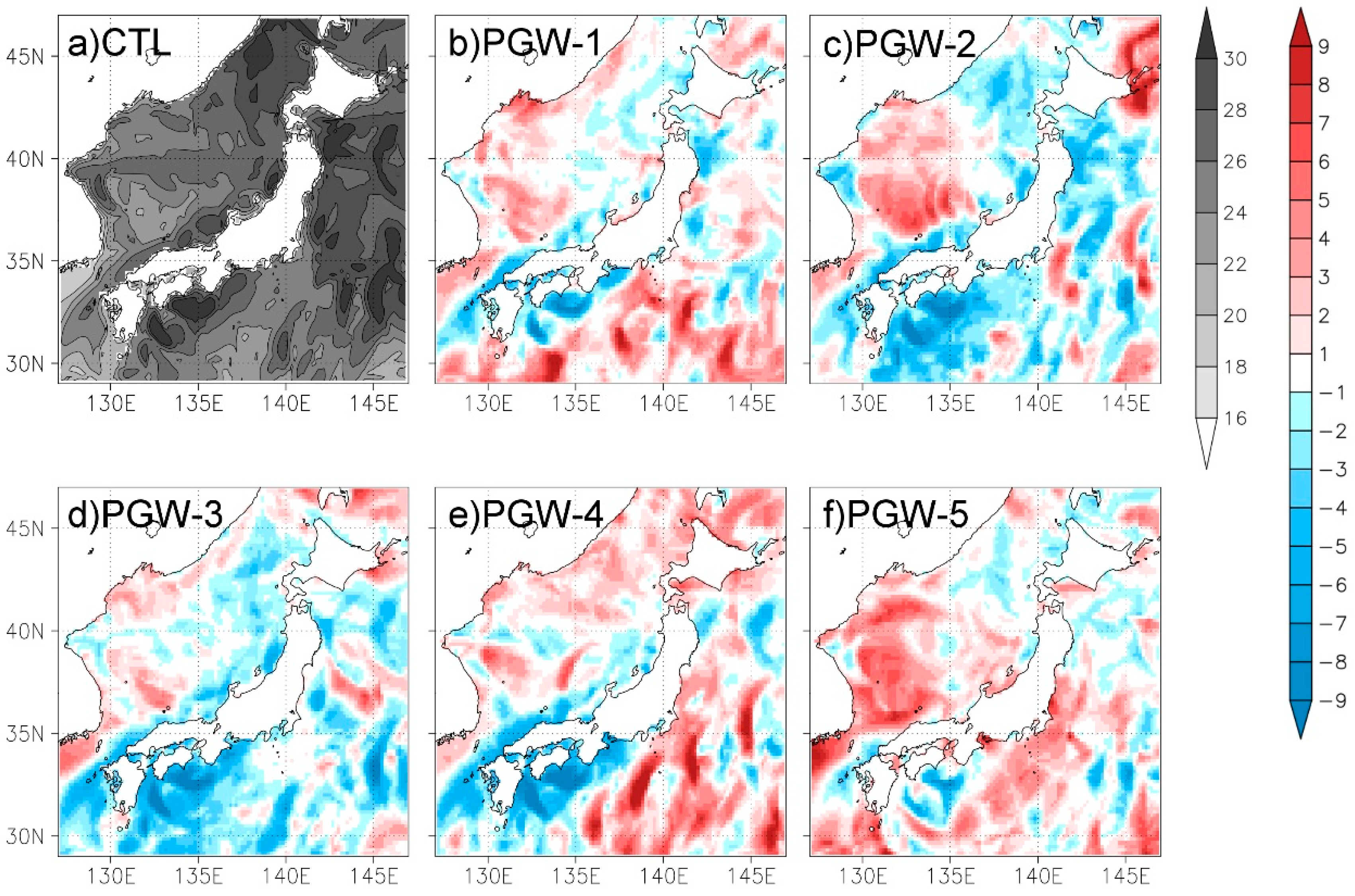
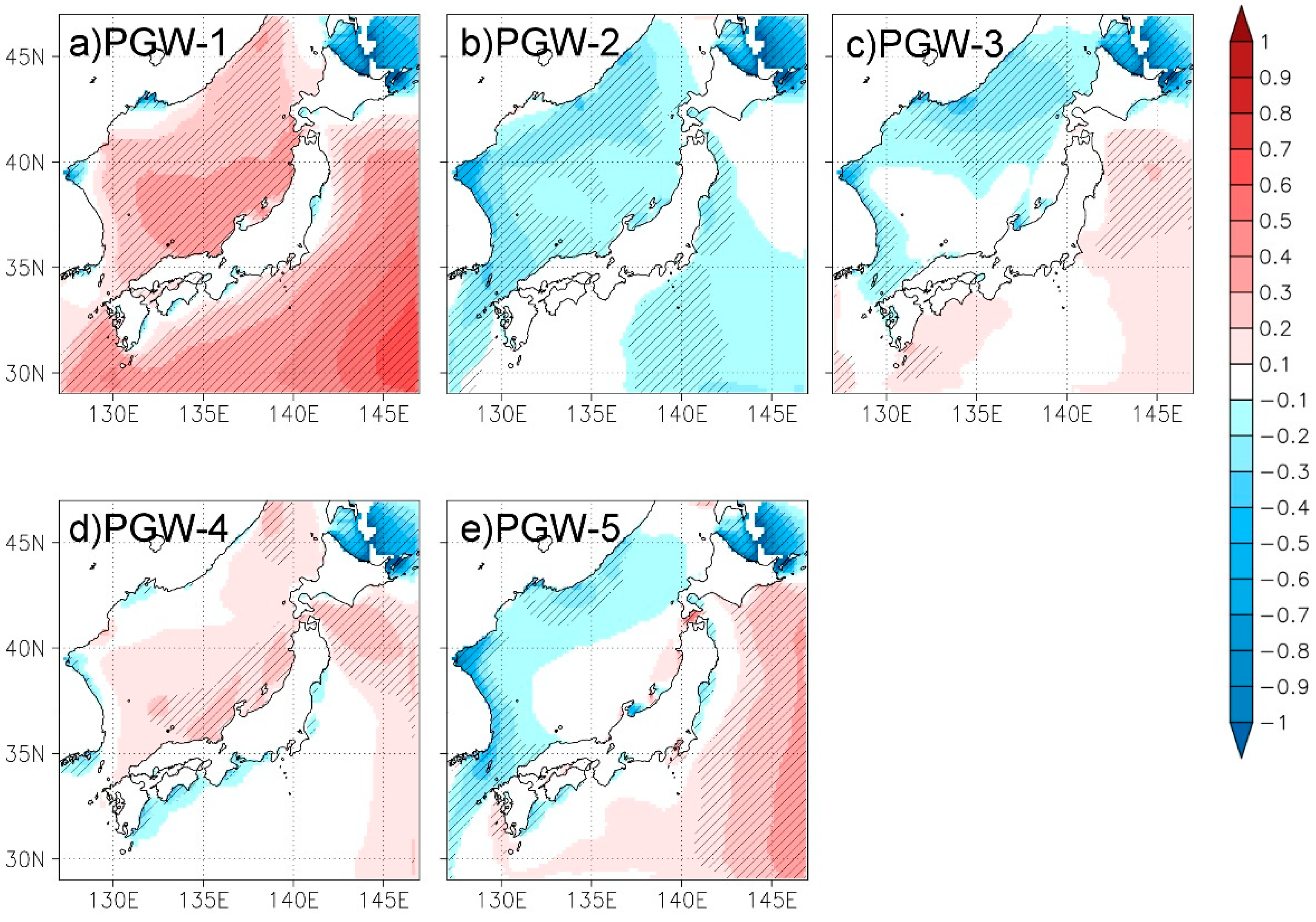
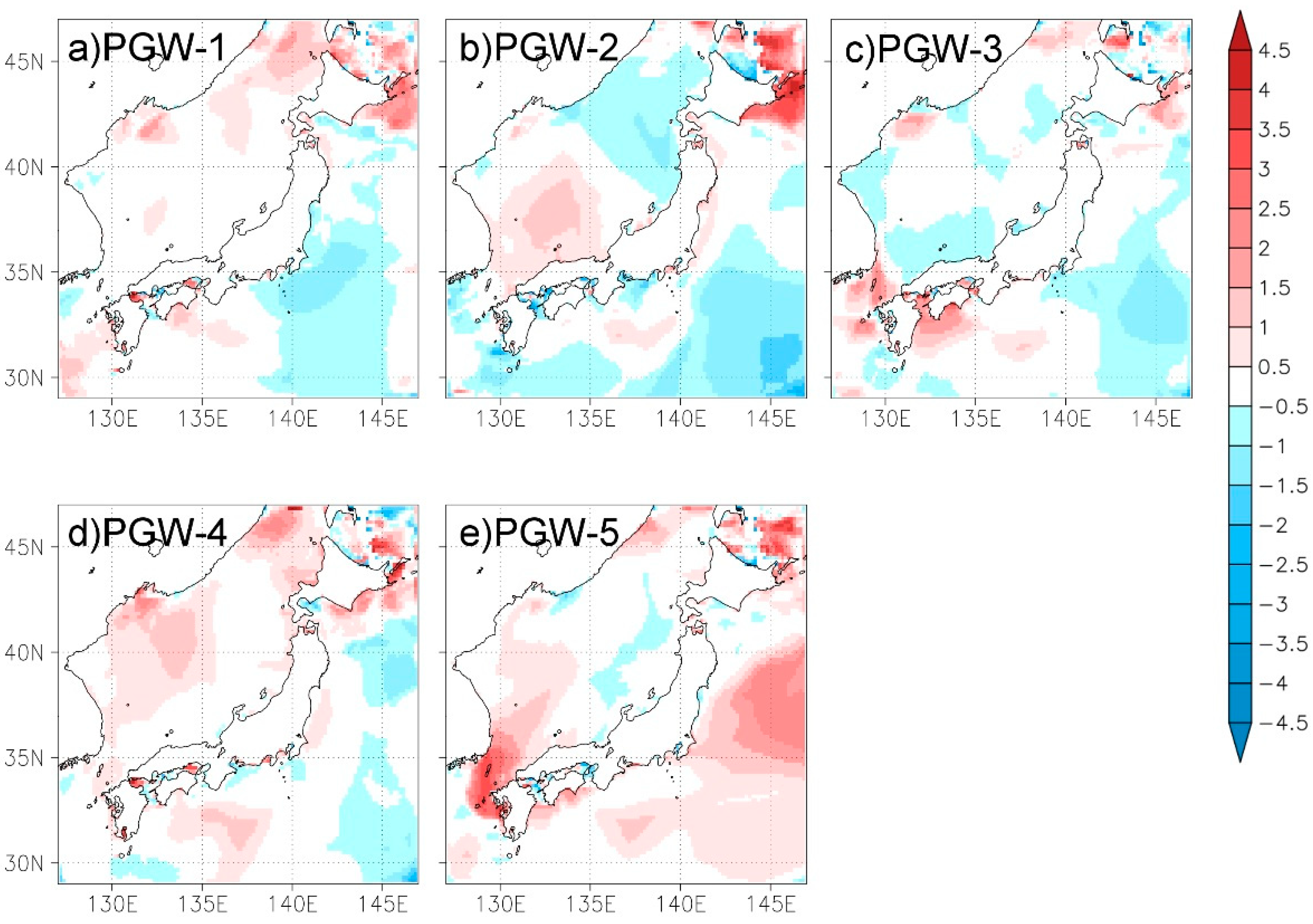
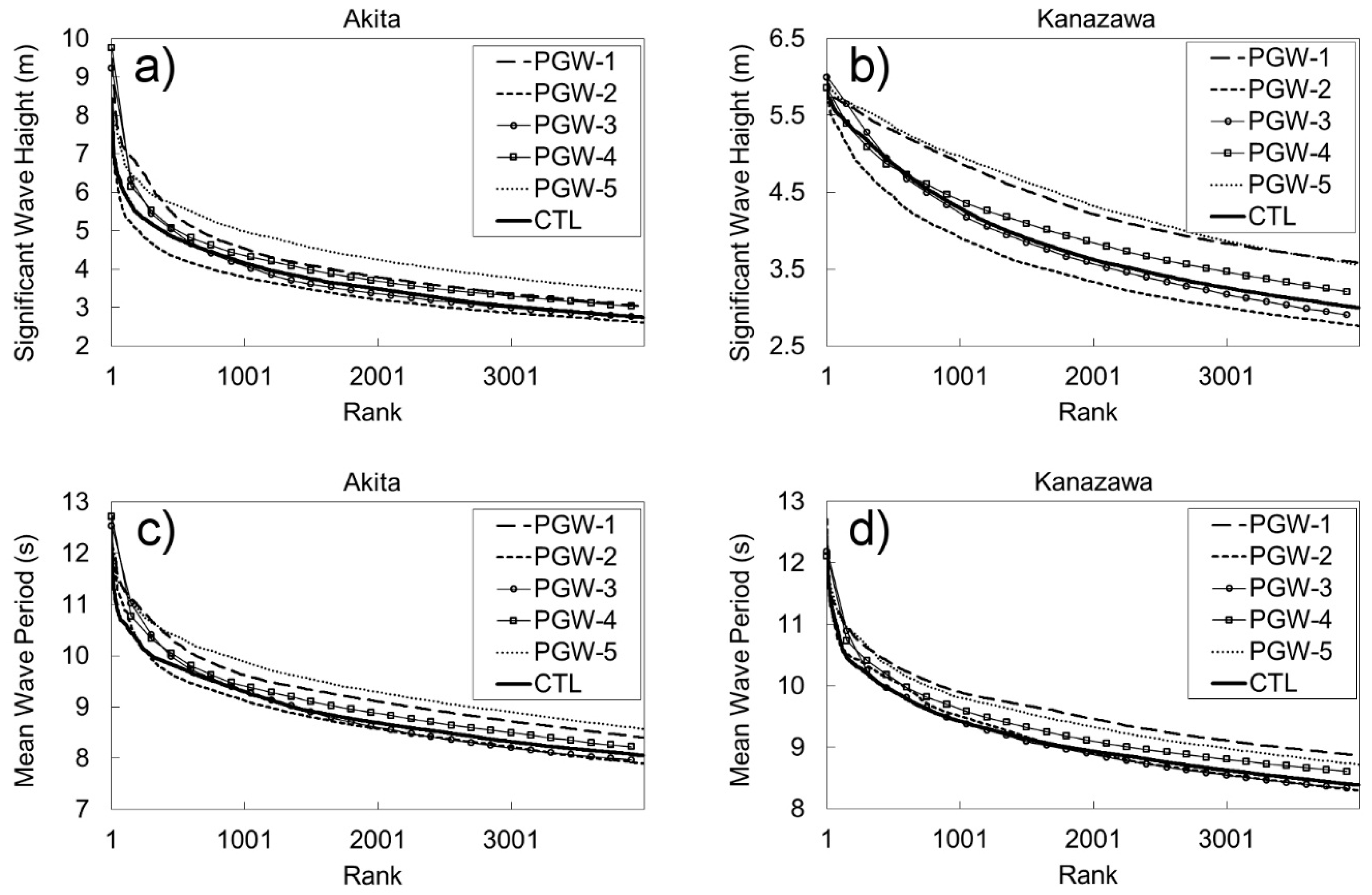

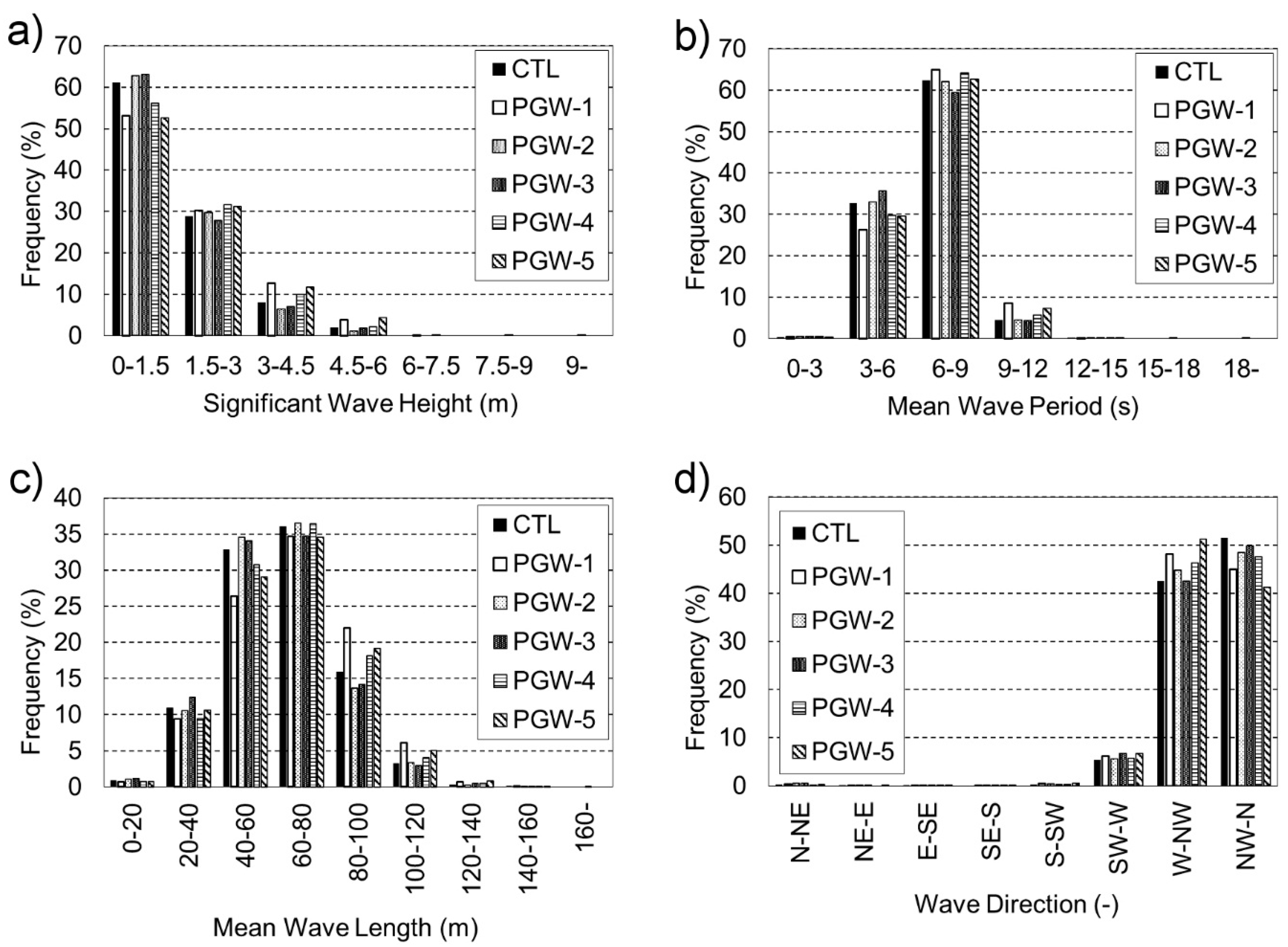
| No. | IPCC ID | Institute and Country | Resolution |
|---|---|---|---|
| 1 | CNRM-CM5 | Meteo-France, Centre Nationale de Resherches Meteorologique (France) | T127, L31 |
| 2 | GFDL-CM3 | Geophysical Fluid Dynamics Laboratory (USA) | 2.0° × 2.0°, L48 |
| 3 | GISS-E2-R | NASA/Goddard Institute for Space Studies (USA) | 2.0° × 2.5°deg, L40 |
| 4 | MIROC5 | Center for Climate System Research (University of Tokyo), National Institute for Environmental Studies, and Frontier Research Center for Global Change (Japan) | T85, L40 |
| 5 | MRI-CGCM3 | Meteorological Research Institute, Japan Meteorological Agency (Japan) | T159, L48 |
| Item | Setting |
|---|---|
| Grid type | Spherical |
| Propagation scheme | ULTIMATE QUICKEST propagation scheme with Tolman averaging technique. |
| Flux computation | Computed with the friction velocity shown in equation (2). |
| Linear input | Cavaleri and Malanotte-Rizzoli with filter |
| Input and dissipation | Tolman and Chalikov (1996) source term package [23]. |
| Nonlinear interaction | Discrete interaction approximation |
| Bottom friction | JONSWAP bottom friction formulation |
| Depth-induced breaking | Battjes–Janssen |
| Bottom scattering | None |
| Triad interaction | None |
© 2019 by the author. Licensee MDPI, Basel, Switzerland. This article is an open access article distributed under the terms and conditions of the Creative Commons Attribution (CC BY) license (http://creativecommons.org/licenses/by/4.0/).
Share and Cite
Taniguchi, K. Variations in Winter Ocean Wave Climate in the Japan Sea under the Global Warming Condition. J. Mar. Sci. Eng. 2019, 7, 150. https://doi.org/10.3390/jmse7050150
Taniguchi K. Variations in Winter Ocean Wave Climate in the Japan Sea under the Global Warming Condition. Journal of Marine Science and Engineering. 2019; 7(5):150. https://doi.org/10.3390/jmse7050150
Chicago/Turabian StyleTaniguchi, Kenji. 2019. "Variations in Winter Ocean Wave Climate in the Japan Sea under the Global Warming Condition" Journal of Marine Science and Engineering 7, no. 5: 150. https://doi.org/10.3390/jmse7050150
APA StyleTaniguchi, K. (2019). Variations in Winter Ocean Wave Climate in the Japan Sea under the Global Warming Condition. Journal of Marine Science and Engineering, 7(5), 150. https://doi.org/10.3390/jmse7050150





